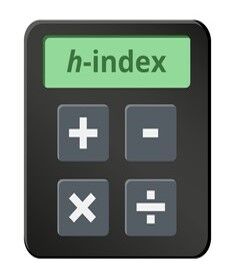مؤشر H: أداه قیّمه لتقییم تأثیر البحث، ولکن لها حدود


یتم حساب مؤشر H من خلال ترتیب منشورات الباحث تنازلیًا بناءً على عدد مرات اقتباسها. یُعرَّف مؤشر H على أنه أعلى رقم H تکون فیه هناک على الأقل H منشورات حصلت کل واحده منها على ما لا یقل عن H اقتباسات.
🟢 مثال:
إذا کان لدى باحث مؤشر H = 10، فهذا یعنی أنه نشر 10 مقالات، تم اقتباس کل واحده منها على الأقل 10 مرات.

مؤشر H هو مقیاس نسبی، أی أن قیمته تعتمد على المجال العلمی والمرحله المهنیه للباحث.
بالنسبه للباحثین المبتدئین، فإن مؤشر H بین 5-10 یعتبر جیدًا.
للباحثین فی منتصف المسیره المهنیه، یکون بین 10-20.
وللباحثین الراسخین، فإن مؤشر H الذی یتجاوز 20 یعد مؤشرًا قویًا على التأثیر والإنتاجیه.

یمیل مؤشر H إلى أن یکون أعلى فی المجالات التی تشهد معدلات نشر واقتباس سریعه، مثل الطب والفیزیاء.
یزداد مؤشر H طبیعیًا مع الوقت مع تزاید عدد المنشورات والاقتباسات.
الباحثون الذین یتعاونون کثیرًا قد یکون لدیهم مؤشر H أعلى مقارنهً بمن یعملون بشکل مستقل.
یراعی مؤشر H الکمیه والتأثیر معًا، لذا فإن نشر أبحاث عالیه الجوده فی مجلات مرموقه أمر بالغ الأهمیه.
یُعد مؤشر H أداه مفیده لمقارنه الباحثین داخل مجال محدد ومرحله مهنیه معینه، لکنه لا یخلو من القیود. لذلک، من المهم تفسیره فی سیاق عوامل أخرى مثل المجال، المرحله المهنیه، وجوده الأبحاث.
إن "مؤشر H الجید" لیس قیمه ثابته، بل هو مؤشر نسبی یعکس الإنتاجیه والتأثیر فی مجال معین.

بالإضافه إلى مؤشر H، هناک مؤشرات أخرى مثل:
مؤشر i10
عدد الاقتباسات الکلی
القیاسات البدیله (Altmetrics)
وکلها تساعد فی تقدیم رؤیه أکثر شمولًا لتأثیر الباحث.
من الضروری تجنّب الإفراط فی الاستشهاد الذاتی، والتأکد من أن الاقتباسات حقیقیه ومُستحقّه.
لا یجب استخدام مؤشر H کونه المعیار الوحید لتقییم الباحث. یجب أخذه بعین الاعتبار إلى جانب:
جوده الأبحاث
مساهماته فی التخصص
التدریس والإشراف الأکادیمی
أکادیمیه سیتا – تدعم الباحثین حول العالم
أکادیمیه سیتا هی شرکه عالمیه تدعم الباحثین، وطلبه الدراسات العلیا، وأعضاء هیئه التدریس من مختلف أنحاء العالم. نحن فخورون بالعمل مع الأکادیمیین فی جمیع مراحل رحلتهم البحثیه.
هدفنا هو دعم المجتمع الأکادیمی ومساعده الباحثین على النمو، والنجاح، ومشارکه أعمالهم مع الآخرین. نحن نؤمن بأهمیه تعزیز البحث العلمی وجعله أکثر تأثیرًا وانتشارًا.
ما هی الخدمات التی نقدمها؟
إذا کان لدیک أی أسئله، استفسارات، أو ترغب فی معرفه المزید عن خدماتنا، فلا تتردد فی التواصل معنا. فریقنا المخصص مستعد لمساعدتک.